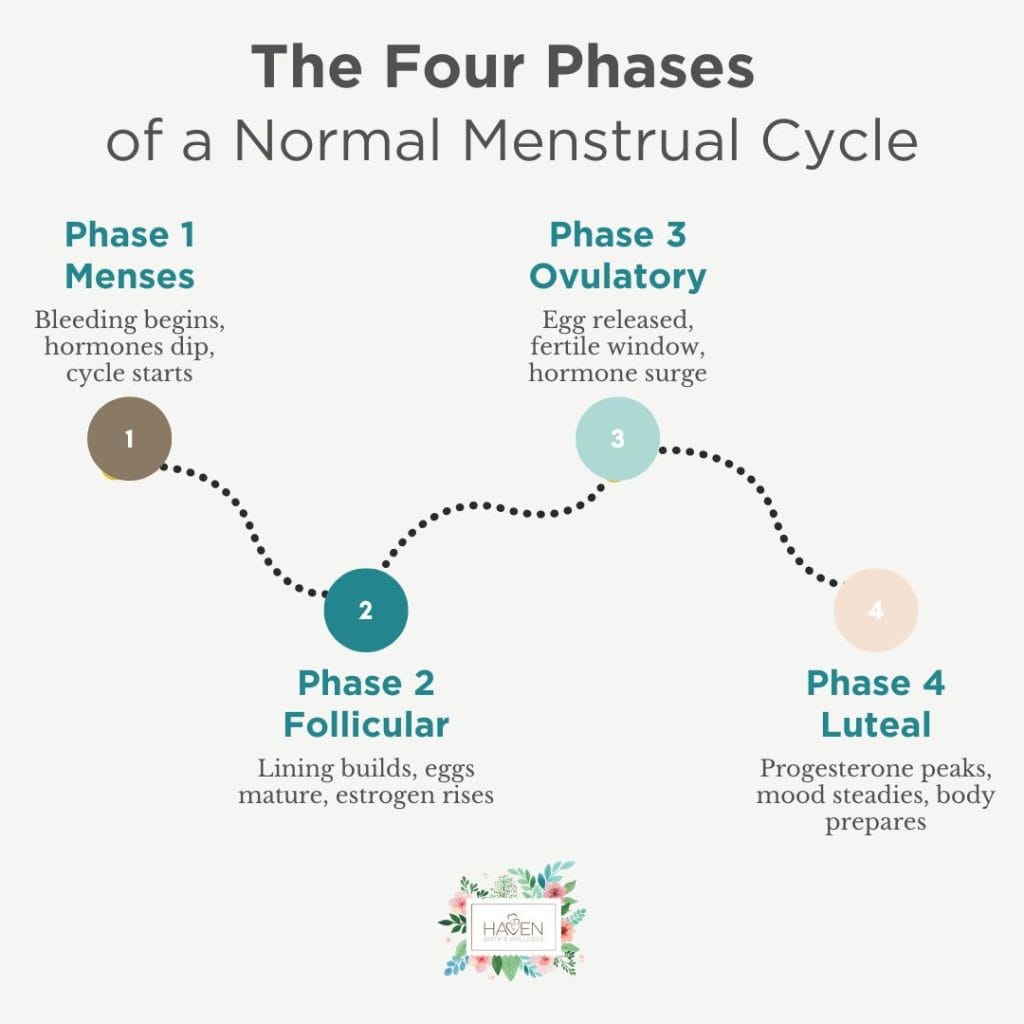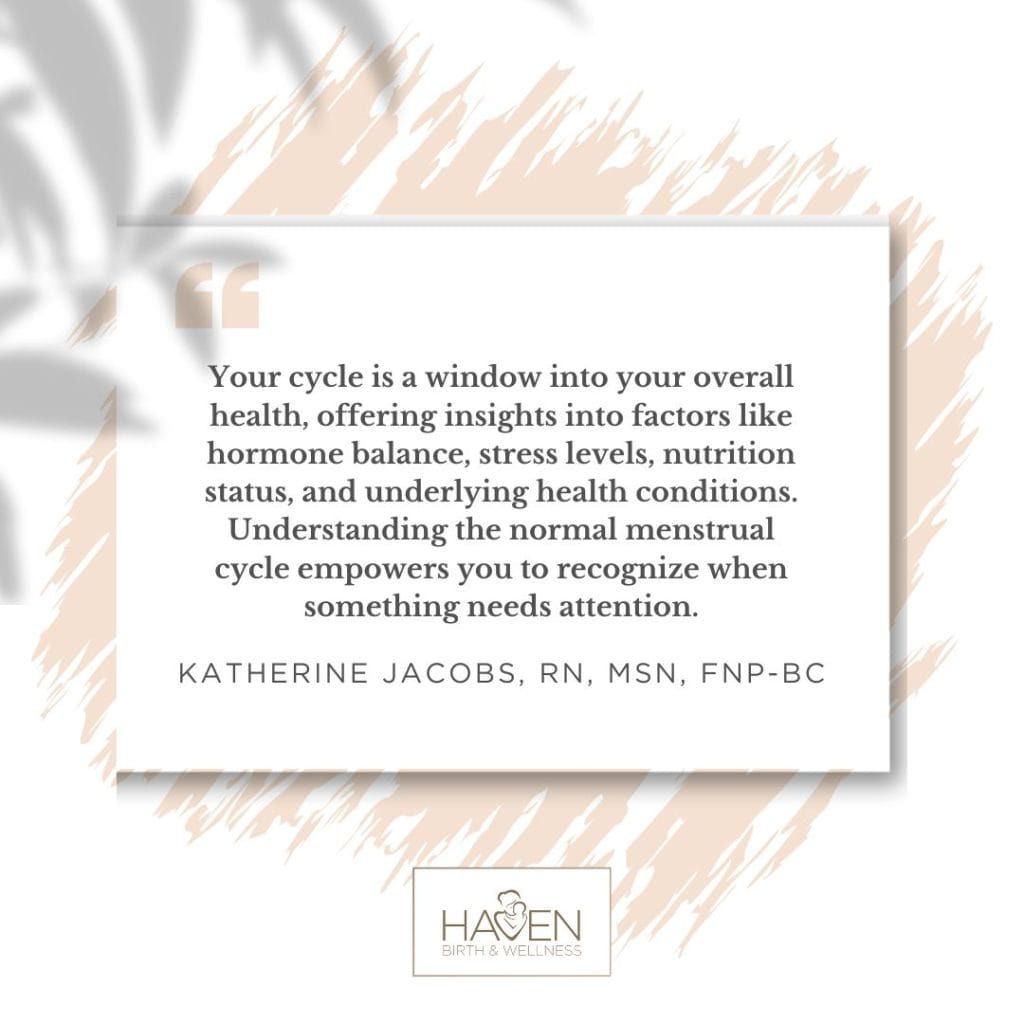

While many of us grow up thinking of our menstrual cycle mostly as “having a period,” there’s so much more happening behind the scenes.
As a family nurse practitioner who works with women daily, I often get questions about what constitutes a normal menstrual cycle. This is such an important topic because understanding your menstrual cycle helps you to know your body better, recognize when something might be off, and approach your healthcare with greater confidence.
It’s helpful to remember that every woman’s cycle is unique to her. So, while a “normal” menstrual cycle will fall within certain parameters, you don’t have to match a textbook definition perfectly to be considered healthy.
Why Do We Have a Menstrual Cycle?
Let’s start with the basics. Why do our bodies go through this monthly process?
At its core, the menstrual cycle is about preparing the body for a possible pregnancy. Whether you’re trying to conceive or not, each hormone involved in a normal menstrual cycle performs a specific job to support that potential. Every phase is your body doing its best in case a baby is created.
What Is the Menstrual Cycle, Exactly?
A normal menstrual cycle isn’t just the days you bleed. It includes all the hormonal shifts and internal changes that happen from the first day of one period to the first day of the next.
How Long Is a Normal Menstrual Cycle?
The average length of a normal menstrual cycle is about 28 days, meaning 28 days from the first day of your bleed to the first day of your next bleed. But “normal” length can vary.
Cycles between 26 and 32 days are often completely healthy, as long as they’re consistent. If they are, then that’s your “normal.” If your cycle starts drifting outside of that range regularly, either shorter or longer, I suggest checking in with your provider.
Keep in mind that women experience hormonal shifts throughout their lives for various reasons, and temporary cycle variations during these times are expected.
When Does It All Start and Stop?
On average, girls begin their normal menstrual cycle between ages 11 and 13, though some may start earlier or later.
On the other end, natural menopause occurs on average around age 50. However, this timing is heavily influenced by many factors, including:
- Genetics
- Chronic health issues, like autoimmune diseases
- Lifestyle factors
- Hormone health
The Four Phases of a Normal Menstrual Cycle
Knowing what’s happening during the four phases of a normal menstrual cycle gives you insight into what your body is experiencing throughout the month.
Phase 1: Menses
This is the week of bleeding, the part many of us think of as our “period.” It marks the start of your menstrual cycle.
Hormone levels are relatively calm during this time, allowing your uterus to shed its lining, which results in bleeding. If you’ve been experiencing PMS symptoms, you’ll likely start feeling better once bleeding begins.
Phase 2: Follicular
Following menses, your body begins preparing for ovulation by starting to thicken the uterine lining and releasing follicle stimulating hormone (FSH). FSH helps mature your ovaries’ follicles, which contain immature eggs.
Technically, the follicular phase overlaps with your menses, but for simplicity’s sake it’s often referred to separately, spanning from the first day post-bleed until the day of ovulation.
Phase 3: Ovulatory
Ovulation signals the end of the follicular phase and is triggered by a surge in luteinizing hormone (LH), which prompts a follicle in your ovary to release an egg. If you’re tracking ovulation, you might notice:
- Cervical mucus changes (thicker, stretchier, with an egg-white consistency)
- Rise in basal body temperature (by more than 0.5 degrees)
- Positive LH test strip (a clue, not a confirmation, of ovulation)
You won’t know the exact day ovulation happens (unless you’re getting imaging in real time!), but these signs provide helpful clues.

Phase 4: Luteal
This is the time following ovulation but before the first day of your next bleed. Progesterone rises to help maintain the uterine lining in case a fertilized egg implants.
If you have strong, healthy progesterone production, this phase can feel amazing. Progesterone is a feel-good hormone that helps with mood stability, supports serotonin and GABA in the brain, increases libido, and helps you sleep better. You may even find you’re more focused, clear, and motivated during this time.
How to Track a Normal Menstrual Cycle
You don’t have to be trying to conceive to benefit from menstrual cycle tracking, which helps you understand what’s normal for your body. Here are some tools I often recommend:
- Normal Menstrual Cycle Tracking: Many free apps offer excellent tracking features that allow you to spot patterns, log symptoms, and get familiar with your cycle.
- Menstrual Cycle Tracking for Fertility: For those trying to conceive, tracking apps like Kindara include basal body temperature as well. I suggest turning off the auto-interpretation settings so you can learn to interpret your data for yourself.
- Hormone Tracking for Fertility: I often recommend Inito, which offers hormone-oriented tracking, to patients who are trying to conceive.
- Educational Resource: Taking Charge of Your Fertility is a great book for deepening your understanding of your menstrual cycle.
What Counts as an Irregular Menstrual Cycle?
Women pass through several life stages that cause irregularities in their menstrual cycle, but these are completely normal and expected. You’ll likely experience irregular cycles during:
- Puberty
- Pregnancy
- Breastfeeding
- Perimenopause
Other irregularities aren’t normal for menstrual cycles variations and may be caused by underlying health issues like:
- Elevated stress
- High-level athletic performance
- Eating disorders
- PCOS
- Endometriosis or adenomyosis
- Luteal phase dysfunction (not having appropriate rise and fall of progesterone)
- Thyroid dysfunction
- High prolactin unrelated to pregnancy or breastfeeding
Symptoms that could indicate a medical issue, even if they’ve always been “normal” for you, include:
- Cycles regularly shorter than 26 or longer than 32 days
- Severe pain
- Vomiting (from menstrual pain)
- Unable to get out of bed or function normally
- Trips to the emergency room
If you’re having debilitating symptoms, even if you have regular menstrual cycle timing, these are not “normal” even if they’ve become familiar to you. Always bring your concerns to a provider who will listen.
For example, some women experience a hormone sensitivity disorder called PMDD, which I’ve written about previously on the blog. If your emotional or physical symptoms before your period affect your ability to function, it’s absolutely worth looking into further.

The Normal Menstrual Cycle: Taking Charge of Your Health
Your cycle is a window into your overall health, offering insights into factors like hormone balance, stress levels, nutrition status, and underlying health conditions. Understanding the normal menstrual cycle empowers you to recognize when something needs attention.
What’s normal for you might be different from what’s normal for your mom, your sister, or your best friend, and that’s perfectly okay. The key is knowing your own patterns and speaking up when something changes or feels off.
If you have concerns or questions about your cycle, don’t hesitate to reach out to your provider. We’re here to help you understand your body and ensure you’re getting the care you need every step of the way.

Katherine Jacobs is a board-certified Family Nurse Practitioner with nearly two decades (17 years) of experience in pediatrics and women's health, along with specialized training from The Institute of Functional Medicine. She focuses on identifying the root causes of illness and guiding patients toward optimal health through personalized, holistic care. With a commitment to integrating lifestyle choices and environmental factors into her treatment plans, Katherine is dedicated to empowering her patients on their wellness journeys. Outside of work, she enjoys outdoor adventures, baking, and spending time with her family.
